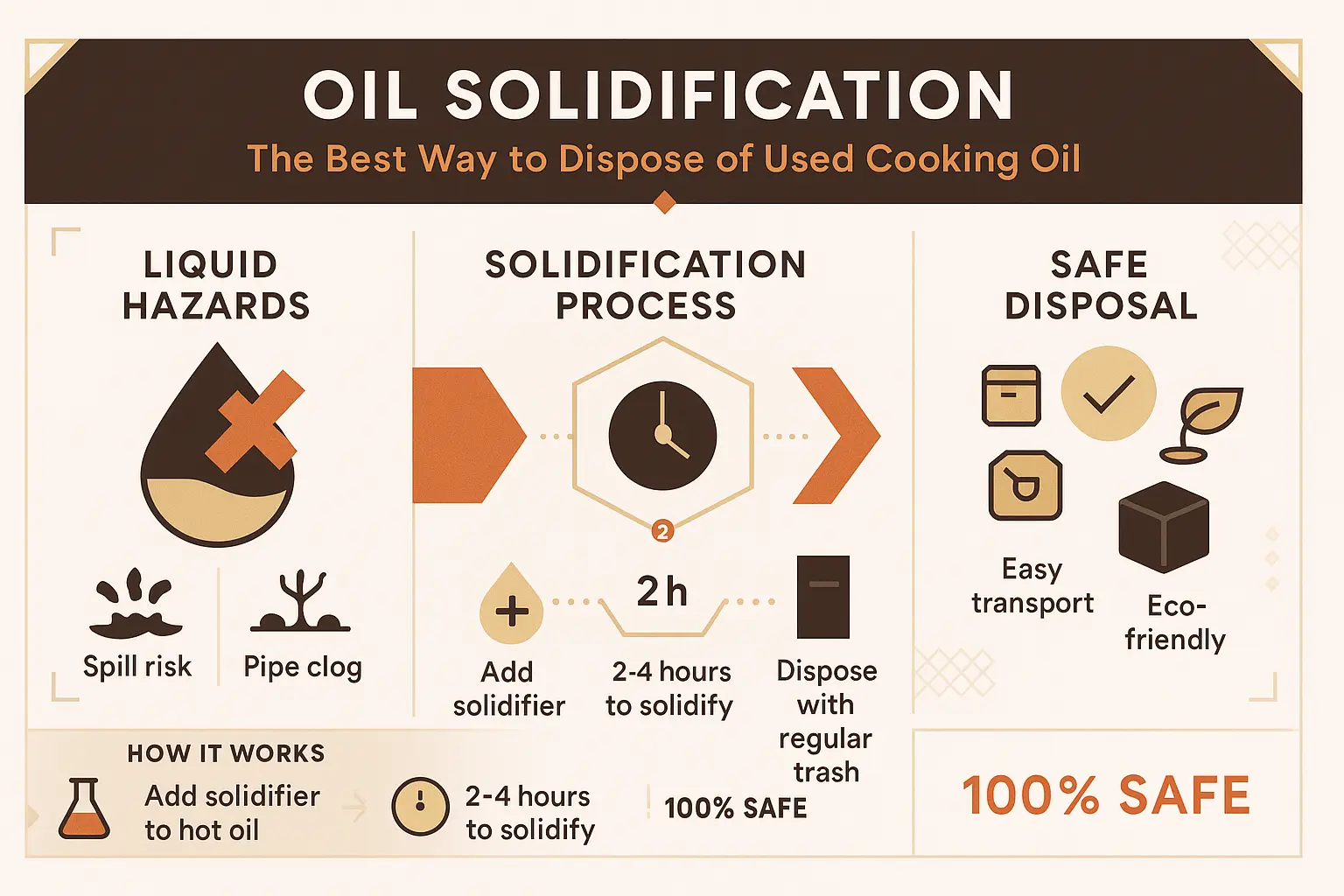Table of Contents
Oil solidification is the process of turning liquid oil into a solid form, making it easier to handle and dispose of. This method is critical for managing used cooking oil, reducing environmental harm, and preventing plumbing issues. Improperly disposing of cooking oil can cause environmental pollution, leading to soil and water contamination and harming wildlife. Used cooking oil should never be poured down the sink, as pouring oil into the sink can cause clogs and serious environmental issues. For instance, one gallon of waste oil can contaminate up to 1 million gallons of fresh water, highlighting the importance of proper disposal. In this article, you’ll learn how oil solidification works, various methods to solidify oil, and the benefits of this simple yet effective technique.
Highlights
- Oil solidification turns used cooking oil into a solid form, making it easier to handle and dispose of while reducing environmental impacts.
- Common methods to solidify cooking oil include using commercial solidifiers, household items like flour or gelatin, and freezing techniques for quick results.
- Solidified cooking oil can be creatively repurposed into products like homemade candles, soap, or even biofuel, promoting sustainability and waste reduction.
Introduction to Cooking Oil Disposal
Proper cooking oil disposal is a key part of keeping your kitchen clean and protecting the environment. When you’re finished cooking, it might be tempting to pour hot oil or used cooking oil down the drain, but this can quickly lead to clogged pipes and costly plumbing repairs. Even tossing waste oil in the trash without preparation can cause environmental damage, as liquid oil can seep into soil and water systems.
Fortunately, there are various methods to dispose of cooking oil safely and responsibly. One of the most effective solutions is to solidify cooking oil before disposal. Using an oil solidifier, such as a polymer powder, or simple techniques like freezing or chilling, you can transform hot oil into a solid mass that’s much easier to handle. This process not only prevents damage to your home’s plumbing but also reduces the risk of environmental contamination. By choosing the right method for your needs, you can ensure that your used cooking oil is disposed of properly, keeping both your kitchen and the planet in better shape.
Understanding Oil Solidification

Oil solidification is the process where cooking oil changes from a liquid to a solid form. The end result is solid oil, which is much easier to manage and dispose of compared to its liquid counterpart. This transformation is not just a neat trick but serves a crucial purpose. Solidifying cooking oil simplifies the disposal process and helps protect public health and the environment from potential harm. Without proper disposal, waste cooking oil can contaminate water sources. Imagine how much easier it would be to manage your used cooking oils if they were in a solid, easy-to-handle form.
Various types of oils, including vegetable fats, animal and vegetable fats, and even diesel, can benefit from solidification. The primary goal here is to convert liquid oil into a solid form to either dispose of it hassle-free or find ways to reuse grease creatively.
Let’s delve deeper into the mechanics and science behind this ingenious process.
How Oil Solidifiers Work
An oil solidifier is a polymer-based substance designed to solidify oil. These solidifiers work by bonding with oil molecules, increasing their viscosity and transforming the oil from a liquid state to a solid form. For example, FryAway is a type of oil solidifier that can convert used cooking oil into a solid mass, making it easier to handle and dispose of. Oil solidifiers attract oil and repel water, ensuring effective separation and solidification. The solidification time can vary, often depending on factors such as the surface area of the solidifier used.
The process begins when the solidifier is added to the liquid oil and thoroughly mixed in. As it bonds with the oil molecules, it thickens the oil, eventually turning it into a hardened oil solid mass. This transformation can be indicated by a change in color, signaling that the oil is being solidified.
Powdered solidifiers are particularly efficient, often producing results in less than an hour.
Types of Oil Solidifiers
There are several types of oil solidifiers available, ranging from commercial products to common household items. Commercial solidifiers come in various forms, including powders, granules, and contained polymers. One popular commercial product is FryAway, a plant-based solidifier that transforms used oil into a solid for easier disposal.
If you prefer a more DIY approach, some common household items like flour or cornstarch can also be used to solidify cooking oil. Another effective option is stearic acid, a natural, long-chain fatty acid derived from animal and vegetable fats. Stearic acid is commonly used to turn liquid oil into a solid form for easier disposal and is also found in products like candles and soap. These options provide a flexible and accessible way to manage your used cooking oils without needing specialized products.
The Science Behind Solidification
The science behind oil solidification involves some fascinating chemistry. One of the key players in this process is Van der Waals forces, which facilitate the attraction between oil molecules. These forces help the oil hydrocarbons come together, contributing to the formation of a solid structure during solidification. Another method, hydrogenation, solidifies oils by adding hydrogen to unsaturated fats, further enhancing the solidification process. The solidification and melting of oil depend on specific temperatures; for example, solidified oil can revert to a liquid state if heated above certain temperature thresholds, making temperature control important in this process.
Polymer powders can enhance this process by creating a gel-like structure that further solidifies the oil. By understanding these scientific principles, we can better appreciate how and why oil solidification works so effectively, making it a reliable method for managing used cooking oils.
Types of Cooking Oils
Cooking oils come in many varieties, each with its own unique properties and uses in the kitchen. Olive oil, for example, is prized for its rich flavor and high content of monounsaturated fats, making it a favorite for dressings and sautéing. Vegetable oils like canola and soybean oil are versatile and commonly used for frying and baking, while animal fats such as lard and tallow add depth and texture to certain dishes.
The type of oil you use can influence how quickly and effectively it solidifies. For instance, olive oil tends to solidify at a higher temperature compared to some vegetable oils, which can affect the solidification time and the method you choose. Understanding the characteristics of different cooking oils helps you select the best approach for disposal, ensuring that the process is both efficient and environmentally friendly. Whether you’re dealing with a pan of frying oil or a bottle of leftover animal fat, knowing your oil type is key to successful solidification and disposal.
Methods to Solidify Cooking Oil
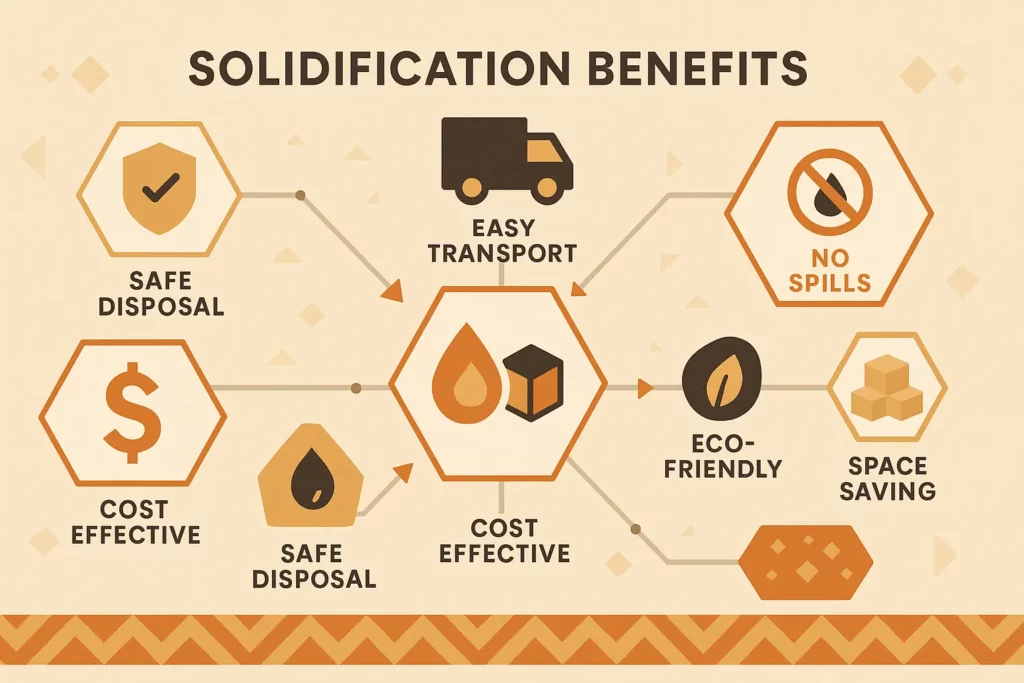
Now that we understand what oil solidification is and how it works, let’s explore some practical methods to solidify cooking oil at home.
Used cooking oil is often heated before solidification, as applying heat can help the solidifier work more effectively.
Whether you have a deep fryer full of used oil or just some leftover frying oil from deep frying, these techniques will help you drain it efficiently.
Freezing and Chilling
Freezing cooking oil is one of the simplest methods to convert it into a solid form. By placing the oil in a freezer-safe container, you can effectively solidify it, making disposal much more manageable. This method is particularly useful for small quantities of oil and requires minimal effort.
Another effective technique is chilling the oil using ice water. This method cools the temperature of the solidification process, providing a quick and practical solution for managing used cooking oil and olive oil.
Both freezing and chilling are efficient ways to solidify cooking oil, offering practical solutions for disposal.
Gelatin Method
The gelatin method involves using gelatin powder to transform liquid cooking oil into a solid form using various methods. This technique is particularly effective for lightweight or moderate-viscosity oils. However, it’s important to note that this method may not be suitable for those following a vegetarian or plant-based diet.
To use this method, first dissolve the gelatin powder in hot water. Once fully dissolved, mix the gelatin solution with the used cooking oil and allow it to set. The result is a firm, solidified mass that can be easily disposed of or repurposed.
Polymer Powder Technique
The polymer powder technique is another effective method for solidifying cooking oil. This involves using substances like cellulose and xanthan gum to transform liquid oil into a solid mass. Products like Waste Cooking Oil Powder are commercially available and can simplify this process.
Using eco-friendly polymer powders like xanthan gum not only solidifies the oil but also reduces the environmental impact of the disposal process. The grain size of the polymer powder can affect the solidification time, so it’s important to choose the right type for your needs.
Storing Solidified Oil
Once you’ve solidified your used cooking oil, proper storage is the next important step in the disposal process. To keep things tidy and safe, transfer the solidified oil into a leak-proof container, such as a plastic bottle or a sturdy jar with a tight-fitting lid. This helps contain any residual grease and prevents spills, making it easier to dispose of the oil in the trash when the time comes.
Labeling your container with the date and type of oil can be helpful, especially if you accumulate solidified oil over time. Store the container in a cool, dry place—like a pantry or cupboard—to maintain the consistency of the solidified oil. For longer-term storage, especially if you’re waiting to collect a larger amount before disposal, the fridge or freezer is an excellent option to keep the oil stable and odor-free. By following these storage tips, you’ll reduce waste, minimize environmental impact, and make the entire cooking oil disposal process more efficient and eco-friendly.
Benefits of Solidifying Used Cooking Oil
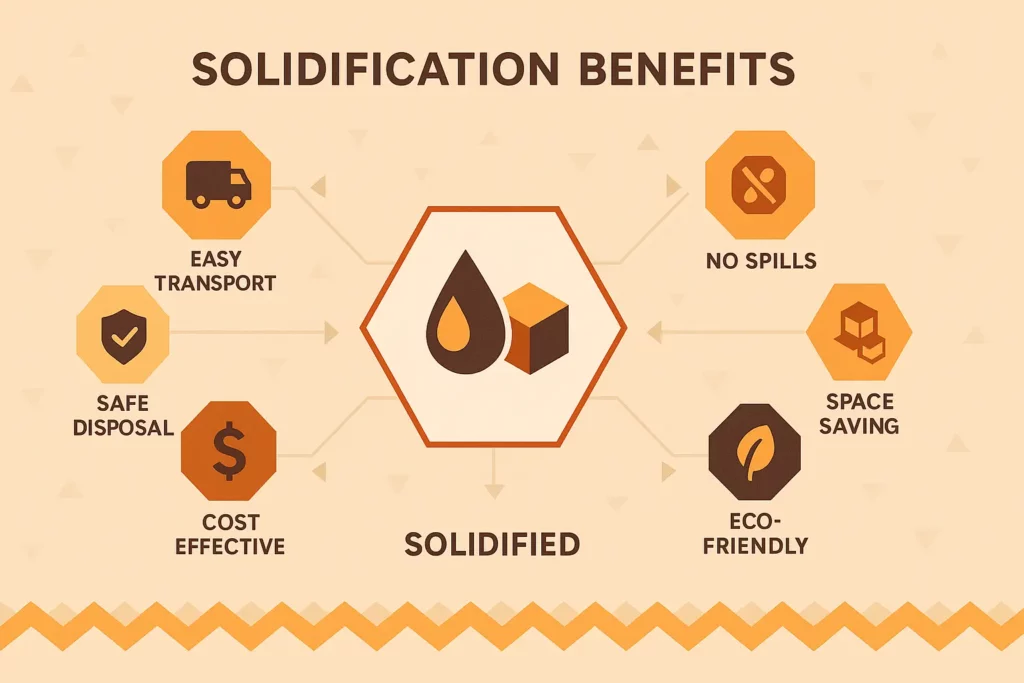
Solidifying used cooking oil offers numerous benefits, from reducing environmental damage to making disposal easier. Proper disposal and recycling of cooking fat, in addition to cooking oil, is also important for reducing environmental harm.
By converting liquid oil into a solid form, we can manage waste oil more effectively and even find creative ways to reuse recycled oil while disposing of it responsibly.
Environmental Impact
Solidifying used cooking oil can have a significant positive impact on the environment. Eco-friendly solidifiers are crucial for efficiently recycling used cooking oil, especially when traditional recycling programs are unavailable. Recycling programs help enforce proper cooking oil disposal practices and contribute to the local economy. A significant portion of sewer overflows in the U.S. is caused by grease. The use of biodegradable polymer powders provides a sustainable method to manage used cooking oil.
Moreover, solidifying cooking oil helps extend its useful life and significantly reduces waste. Small amounts of solidified cooking oil can be composted, and larger quantities can be processed at industrial compost facilities. Discarding used cooking oil in landfills gives microbes an energy source, which can be converted to renewable energy, further promoting sustainability.
Additionally, biodiesel produced from solidified cooking oil burns more cleanly than traditional fossil fuels, helping to reduce greenhouse gas emissions.
Ease of Disposal
One of the most practical benefits of solidifying oil is the ease of disposal. Handling solidified oil significantly decreases the risk of spills and burns during disposal. Solidified cooking oil is more convenient for home cooks to discard and remains gelatinized during garbage collection. It can be easily and safely disposed of in the trash, without harming plumbing systems.
Proper disposal of solidified oil prevents it from clogging drains and causing environmental issues. Fats, oils, and grease can congeal and cause clogs in sewer systems, leading to overflows. Using solidified oil promotes safe waste management and overall environmental protection.
Extending Shelf Life
Solidifying cooking oil can also help extend its shelf life. Filtering used cooking oil before storage is crucial for maintaining its quality and usability. Using gelatin can create a firm texture in the oil, although it may not fully solidify it. Carefully measuring the gelatin is important to avoid excess liquid during the solidification process.
Proper storage in a plastic bottle or freezer-safe container ensures the oil remains usable for an extended period, reducing waste and maximizing its potential in a jar, maintaining consistency.
Creative Uses for Solidified Cooking Oil
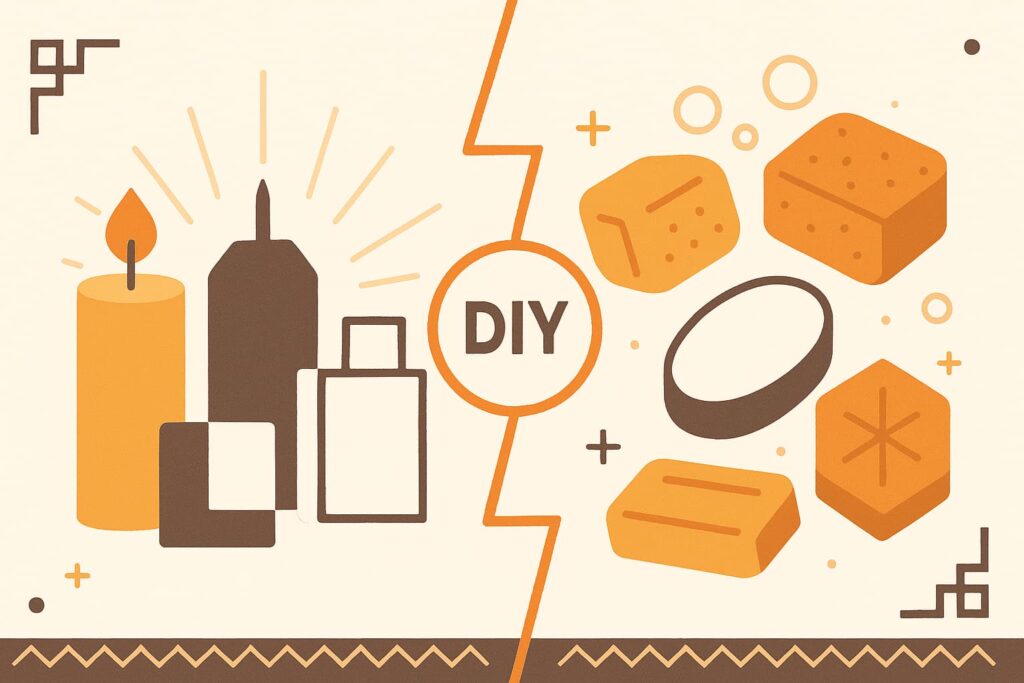
Once you’ve solidified your used cooking oil, you don’t have to throw it away. There are several creative and practical ways to repurpose it, turning waste into something useful and even fun. When reusing solidified cooking oil for creative purposes, keep in mind that the flavors absorbed from previous cooking can affect the final product.
Homemade Candles
One common method to repurpose solidified cooking oil is to create homemade candles. This technique is becoming increasingly popular among those looking to recycle. To do this, mix paraffin wax with the solidified oil, stir in scented wax and color, position the wick, and pour the mixture into a mold. Allow it to cool, and you’ll have a unique, eco-friendly candle.
The main materials needed for this process include solidified cooking oil, paraffin wax, a wick, scented oils, and a mold. This activity not only reduces waste but also provides a fun and creative outlet.
Soap Making
Solidified cooking oil can also be transformed into soap. This process involves mixing the solidified oil with lye and water to facilitate a chemical reaction that creates soap. Creating soap from solidified cooking oil helps repurpose waste and can lead to environmentally friendly household products.
The steps are simple: mix the solidified oil with lye and water, pour the mixture into a mold, and allow it to set. The result is a bar of soap that is both practical and eco-friendly.
Biofuel Production
Another innovative use for solidified cooking oil is converting it into biofuel. The chemical reaction involved in this process is known as transesterification, where the oil is transformed into biodiesel. In biodiesel production, fresh oil is often used as a benchmark for purity and quality, and used cooking oil must be filtered and treated to approach the quality of fresh oil. This biodiesel can be blended with petroleum diesel and used in older vehicles and tractors, providing a sustainable alternative to traditional fuels.
Using waste cooking oil for biodiesel production not only reduces environmental waste but also contributes to the creation of a cleaner-burning fuel. This practice supports recycling efforts and underscores the versatility of used cooking oil.
Safety Tips for Handling Hot Oil
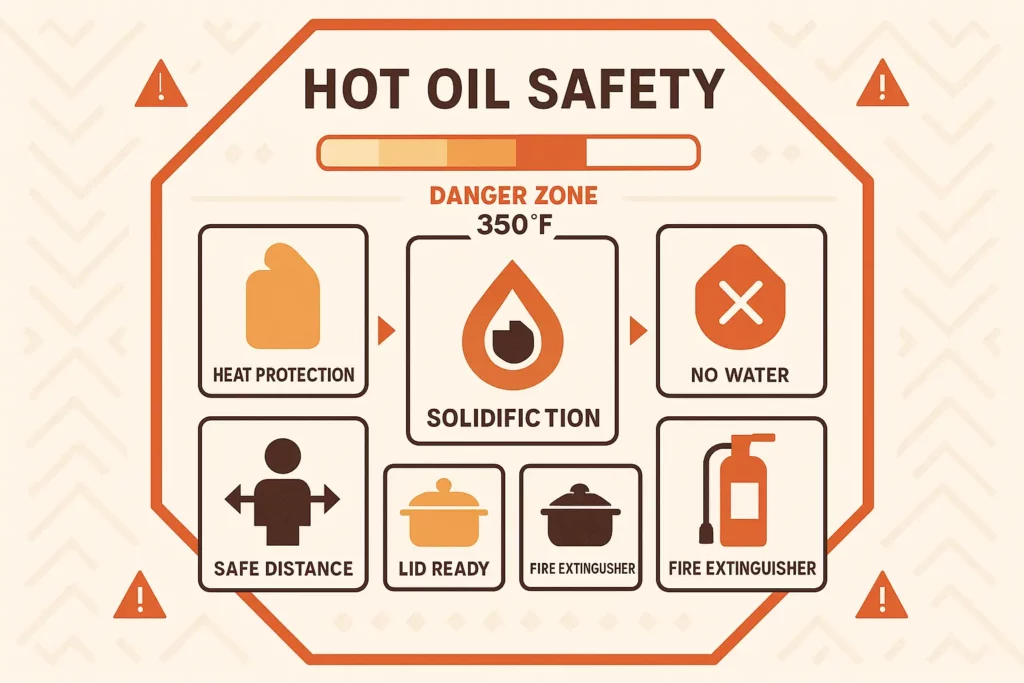
Handling hot oil can be hazardous if not done correctly. The stove is a common source of oil fires, so it’s important to monitor hot oil closely when cooking on the stove. To ensure safety, always wear protective gear like heat-resistant gloves and aprons when managing hot oil. It’s crucial to keep an eye on the oil during cooking to avoid overheating and potential fires.
If you notice the oil starting to smoke, turn off the burner immediately, as this is a sign that the oil is too hot. Using slow heating methods can help prevent the oil from reaching its ignition point, ensuring a safer cooking experience.
Preventing Oil Fires
Preventing oil fires starts with using appropriate cookware and keeping a fire extinguisher readily accessible in the kitchen. Signs that an oil fire may occur include smoke arising from the oil. Additionally, a strong smell can be detected prior to ignition. Always stay in the kitchen and monitor the food when cooking with hot oil.
If a fire does start, cover the pan with a lid or a metal pot to smother the flames and cut off the oxygen supply. This can effectively extinguish the fire and prevent it from spreading.
By taking these precautions, you can significantly reduce the risk of oil fires and ensure a safer cooking environment. Remember, prevention is always better than dealing with an emergency.
Managing Oil Spills and Fires
In the event of an oil spill or fire, follow these steps:
- Turn off the heat source immediately.
- In case of a fire in the oven, first turn off the heat. This will allow the fire to starve of oxygen.
- Small flames can be extinguished by smothering with salt or baking soda.
Covering the flames with a metal lid can effectively extinguish small oil fires by cutting off the oxygen supply. Never attempt to put out an oil fire with water, as this can cause the flames to spread.
By following these steps, you can manage oil spills and fires safely and effectively.
Summary
Proper disposal of used cooking oil is crucial for protecting our environment and ensuring safe waste management. Oil solidification offers a practical and effective solution, transforming liquid oil into a solid form that is easier to handle and dispose of. We’ve explored various methods to solidify cooking oil, including freezing, using gelatin, and polymer powders, each with its own benefits and applications.
Solidifying used cooking oil not only simplifies disposal but also opens up creative opportunities for repurposing, such as making candles, soap, and even biodiesel. By adopting these practices, we can contribute to a more sustainable and eco-friendly lifestyle. Remember, every small action counts, and proper oil disposal is a step in the right direction.

